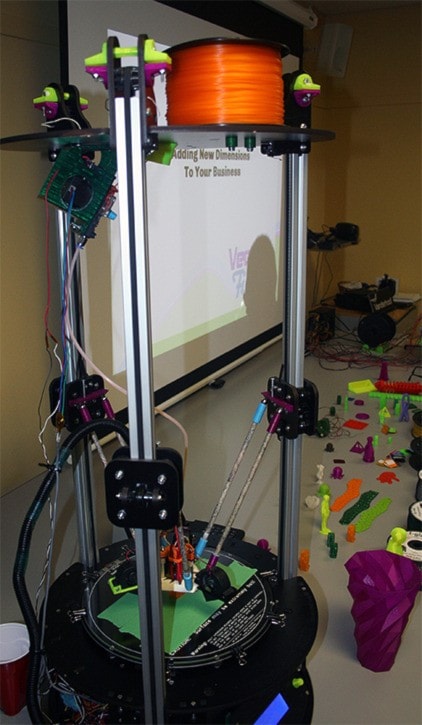A local organization is looking at purchasing a 3-D printer that would be available to the community to use.
The demonstration was led by John Makowski who owns the first company in Northern B.C. to work with these printers.
The printer he brought to show everyone on Friday, Feb. 28 was one of what he calls "the hot mechanical glue gun" variety. The machine works by using a motor to take from a spool of plastic, of which there are many varieties, and heating it up to then place on a flat surface and begin creating an object layer by layer.
If you want an idea of how fast it goes, imagine an old regular paper printer that has to lay down a layer of ink one line at a time. It's a little slow to watch but after only half an hour Makowski showed the audience the three inch figurine the printer made.
There are a few other kinds of 3-D printers that use lasers and can work with metal but the one at the demonstration was a cheaper design and would cost $1,000 if Makowski hadn't added a few parts of his own onto it bringing it up from stock price.
It took him about 20 hours to assemble that printer from its kit and then about 300-400 hours of calibrating and testing to get it to create products in a repeatable way.
"The reason Community Futures is interested in this, we're interested in helping people with small businesses and we see an opportunity in 3-D printing for a lot of people to try and work on," said Graham Stanley from Community Futures Stuart-Nechako. Stanley's company is looking at purchasing a printer for the local region.
"So why is this a big deal?" asked Makowski. "Well it allows small and medium businesses to produce a prototype easier. Also, if you need to make changes to your prototype, you don't need to go get another mold or retool a bunch of machines. Also, it allows us to have more freedom in our design."
It would also help a small business keep their inventory low.
Makowski spent the first part of the demo debunking myths about 3-D printed guns and why we shouldn't be worried about them.
"Yes there is completely 3-D printed single shot gun out there that has been made," said Makowski. "But every manufacturing technology makes harmful things and printing is really illsuited to making stuff like that." Compared to lathes and other machining technology, 3-D printers are inefficient weapons makers.
But they are very efficient in terms of material used. Other manufacturing processes can leave up to 90 per cent of their material in waste while a 3-D printer only leaves about 5 to 10 per cent.
The density of objects can be completely customized as well. Anything from completely hollow to completely solid and everywhere in between is up to the designer.
Another nice thing is that objects can be built that couldn't be built in any other way. A gear box can be made that couldn't be put together or taken apart without breaking it.
There are also printers out there that can work with two materials at once, one of them being the normal plastic and the other is a material that can be dissolved in water so the printed object can be more complex on the inside, with this new material being removed in the end.
The last thing Makowski showed everyone was the whole process from designing an object on computer software to transferring the converted file onto a memory card and then plugging the card into the printer, selecting the right design and then letting the machine do its work.
